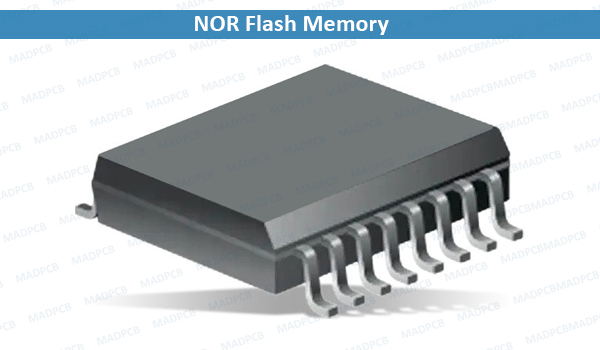What Is NOR Flash?
In NOR Flash, each cell has one end connected directly to ground, and the other end connected directly to a bit line. This arrangement is called “Not OR (NOR) Flash” because it acts like a NOR gate: when one of the word lines (connected to the cell’s CG) is brought high, the corresponding storage transistor acts to pull the output bit line low. This flash continues to be the technology of choice for embedded applications requiring a discrete non-volatile memory device. The low read latencies characteristic of such devices allow for both direct code execution and data storage in a single memory product.
Programming
A single-level NOR memory cell in its default state is logically equivalent to a binary “1” value, because current will flow through the channel under application of an appropriate voltage to the control gate, so that the bitline voltage is pulled down. A NOR device cell can be programmed, or set to a binary “0” value, by the following procedure:
- an elevated on-voltage (typically >5 V) is applied to the CG
- the channel is now turned on, so electrons can flow from the source to the drain (assuming an NMOS transistor)
- the source-drain current is sufficiently high to cause some high energy electrons to jump through the insulating layer onto the FG, via a process called hot-electron injection.
MADPCB provides printed circuit board (PCB) manufacturing, assembly and design services, and components sourcing and IC programming value-added services.
Erasing
To erase a flash cell (resetting it to the “1” state), a large voltage of the opposite polarity is applied between the CG and source terminal, pulling the electrons off the FG through quantum tunneling. Modern NOR memory chips are divided into erase segments (often called blocks or sectors). The erase operation can be performed only on a block-wise basis; all the cells in an erase segment must be erased together. Programming of NOR cells, however, generally can be performed one byte or word at a time.
NOR Flash vs. NAND Flash Memory
Flash Memory is an electronic non-volatile computer memory storage medium that can be electrically erased and reprogrammed. The two main types of flash memory, NOR and NAND flash, are named for the NOR and NAND logic gates. NOR and NAND flash use the same cell design, consisting of floating gate MOSFETs. The differ at the circuit level: in NAND flash, the relationship between the bit linear and the word lines resembles a NAND gate; in NOR, it resembles a NOR gate; this depends on whether the state of the bit line or word lines is pulled high or low.

